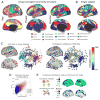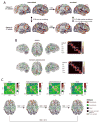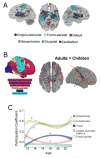Development of large-scale functional networks from birth to adulthood: A guide to the neuroimaging literature
- PMID: 28161313
- PMCID: PMC5538933
- DOI: 10.1016/j.neuroimage.2017.01.079
Development of large-scale functional networks from birth to adulthood: A guide to the neuroimaging literature
Abstract
The development of human cognition results from the emergence of coordinated activity between distant brain areas. Network science, combined with non-invasive functional imaging, has generated unprecedented insights regarding the adult brain's functional organization, and promises to help elucidate the development of functional architectures supporting complex behavior. Here we review what is known about functional network development from birth until adulthood, particularly as understood through the use of resting-state functional connectivity MRI (rs-fcMRI). We attempt to synthesize rs-fcMRI findings with other functional imaging techniques, with macro-scale structural connectivity, and with knowledge regarding the development of micro-scale structure. We highlight a number of outstanding conceptual and technical barriers that need to be addressed, as well as previous developmental findings that may need to be revisited. Finally, we discuss key areas ripe for future research in order to (1) better characterize normative developmental trajectories, (2) link these trajectories to biologic mechanistic events, as well as component behaviors and (3) better understand the clinical implications and pathophysiological basis of aberrant network development.
Keywords: Brain development; Connectomics; Functional connectivity; Graph theory; Resting-state functional MRI.
Copyright © 2017 Elsevier Inc. All rights reserved.
Figures





References
Publication types
MeSH terms
Grants and funding
- R01 MH086654/MH/NIMH NIH HHS/United States
- UG3 OD023349/OD/NIH HHS/United States
- R01 MH107508/MH/NIMH NIH HHS/United States
- R01 MH105538/MH/NIMH NIH HHS/United States
- P50 AA010760/AA/NIAAA NIH HHS/United States
- R00 MH091238/MH/NIMH NIH HHS/United States
- U01 DA041148/DA/NIDA NIH HHS/United States
- P60 AA010760/AA/NIAAA NIH HHS/United States
- R01 MH115357/MH/NIMH NIH HHS/United States
- L40 MH087431/MH/NIMH NIH HHS/United States
- K99 MH091238/MH/NIMH NIH HHS/United States
- R56 MH086654/MH/NIMH NIH HHS/United States
- R01 MH096773/MH/NIMH NIH HHS/United States
LinkOut - more resources
Full Text Sources
Other Literature Sources

